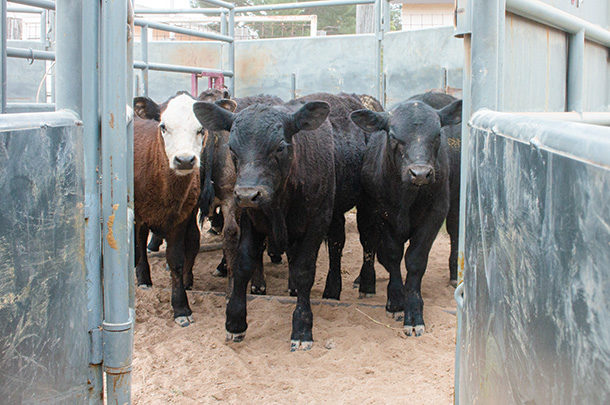With fall approaching, we expect the normal abundance of calves being sold. In the U.S., the majority of cow herds are managed for spring calving, which gives us a large run of calves in the fall. Many of these calves will go through at least one sale barn, be shipped for several hours, have feed and water restricted, and be commingled with calves from several different operations. With all of these stressors stacked together, is it really a wonder that these calves get sick?
What about the origin of these calves? Were they from well-managed operations, or did they come from a less intensively managed operation? As we prepare these calves for the next phase of their lives, we need to consider all opportunities to improve their chances of survival while getting them off to a good start and minimizing any potential issues.
Bovine respiratory disease (BRD) has long been identified as one of the costliest sicknesses in cattle. A recent study conducted by Derrell Peel concluded that over $907 million is lost yearly to death loss in calves affected by BRD. This figure only considers death loss but does not include the cost of treatment and reductions in performance. The cost of treating cattle for BRD varies widely depending on treatment strategy. Traditionally, there is a range of $23 to $42 per treatment. It is widely accepted that the cost of treatment has gone up dramatically over the last several years.
These high-risk calves warrant advanced receiving-cattle programs to promote their value at the end of the feeding period. If we go back a few years to a report on Iowa Tri-County Steer Carcass Futurity (2002-11), the observed effects of health-related events on profitability of cattle are more than expected.
If cattle were treated once or more, they had a reduced value of $120 per head, while cattle requiring two or more treatments were $365 behind healthy cattle.
This report included losses for final product quality, increased production cost and death loss. This type of information should challenge the industry to ask, “What can we do to give these cattle a better chance of surviving and becoming profitable?”
Changing methods
Maintaining normal function of the gastrointestinal (GI) tract in these calves can be difficult because of the multiple stressors they encounter. However, maintaining this normal function is the primary goal of feeding probiotics. Probiotics can be a valuable component of a good management and nutrition program to diminish the impacts that stress can have on the GI tract of these calves. An animal in a normal state is not suffering from disease or challenges and is performing to its genetic potential. What else can we ask for? An effective probiotic will help tip the scale to the positive side when we do our part as cattle managers.
We are in the middle of a transitory period in cattle production with less reliance on commonly used products of the past and more acceptance of “natural” solutions. This change is being spurred by several factors, including consumer demand, export markets and government regulations. Probiotics have gained quite a bit of attention and acceptance in the last several years.
When we turn on the TV, we can’t help but see an ad for a probiotic or a food containing a probiotic. The scope and breadth of research that is being conducted with probiotics is amazing. Learning how simple bacteria can impact the entire microbiome of an animal and influence its ability to withstand challenges and perform to its genetic potential was once a mind-boggling concept but today is readily accepted and available. This leads us to the question, “What are probiotics doing to impact our cattle?”
Cleaning the GI tract
Bacilli are active bacteria that function to hunt and kill pathogens present in the GI tract. They are also known to produce effective amounts of enzymes to digest the diet the animal is consuming. Additionally, bacilli are extremely hardy and can be added in many different types of cattle feeds while maintaining their own viability.
For bacillus organisms, there are vast differences between various strains within the same species. A research study conducted in 2007 reported up to 18% genetic difference between strains of Bacillus subtilis. To put that into perspective, the diversity that exists between the genome of a mouse and the genome of a human is only 10%. The difference between strains in a single species is so vast that understanding how each bacteria within a product function is difficult. This makes having research that is specific to the product strain crucial in knowing if you’re purchasing a probiotic that will have a true benefit to the animal.
The biggest driver for bacterial probiotics is the ability to impact gut health. This is accomplished through several modes of action that are dependent on the probiotic being used. Following is a list of the recognized modes of action for bacillus species. Not all species or strains have all the modes of action.
- Direct antagonism by bacteriocins, which act like natural antibiotics
- Competitive exclusion for binding sites
- Improved barrier function of the GI tract
- Reduction of inflammation, thus altering intestinal properties for colonization and persistence
- Stimulation of innate immune response
Bacillus species are known to produce bacteriocins that have antibacterial properties. Several lab studies have shown reduced growth of pathogenic bacteria when probiotic bacillus is present. There is also a demonstrated ability to improve the mucosal barrier on the gut, which impedes pathogens from adhering to the gut wall.
Bacilli are also known to compete for nutrients that are vital for pathogens and to occupy the same binding sites used by pathogens. These functions help the GI tract remain normal and allow for better nutrient absorption.
Some species of bacilli can produce effective levels of enzymes to help digest the ration they encounter. The production of enzymes is enhanced by the rapid replication of bacilli which occurs every 20 to 40 minutes. Bacilli will produce enzymes needed to digest the diet animals are consuming. This means that if a high-fiber diet is consumed, enzymes needed to digest fiber will be produced, while if a higher-starch diet is fed, enzymes needed for this diet will be produced. Recent trials and field observations have shown improvements in fiber and starch digestion in the 1% to 3%, and 11% range, respectively.
Caring for your tools
Many of the bacterial strains used in currently available probiotic products must be handled and delivered to the cattle with care to make sure they remain viable. For example, many large feedlots and dairies store the products in a freezer and then use a micromachine to add probiotics to their rations. This works well, but it limits the use of these products in other feed types and feeding systems.
Liquid feeds, grazing minerals, pellets, cubes, cakes, blocks and tubs are all very commonly used for cows and calves. Because of their robustness under many environmental conditions, specific bacilli have been tested in the aforementioned feeds and have been shown to be a viable option. This makes delivery of a probiotic much more readily available for many operations that have been challenged to deliver an effective probiotic previously.











